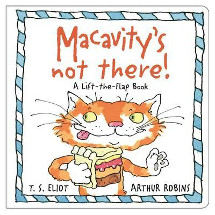Macavity's not there by T. S. Eliot

Ill. by Arthur Robins. Faber and Faber, 2016. ISBN 9780571328635
In 1939, T.S. Eliot wrote his iconic Old
Possum's book of practical cats which became the
foundation for Andrew Lloyd Webber's musical 'Cats'. Within that
collection, is a poem which begins
Macavity's a mystery cat: he's called the Hidden Paw.
For he's the master criminal who can defy the Law.
He's the bafflement of Scotland Yard, the Flying Squad's despair:
For when they reach the scene of crime - Macavity's not there!
It goes on.
Macavity's a ginger cat, he's very tall and thin;
You would know him if you saw him, for his eyes are sunken in
Drawing on those two lines as the starting point and the constant
refrain of the original of 'Macavity's not there' , Arthur Robins
has again relied on the poem to create a wonderful lift-the-flap
book encouraging young children to investigate just where this
elusive cat might be. Is he in the bedroom? The bathroom? Perhaps
the kitchen? Maybe the rabbit hutch? Ahhh, there he is! Why didn't
we think of there in the first place?
Using very distinctive illustrations, Robins brings Macavity to life
just as he did in his 2014 version of the original poem by T.S.
Eliot. But as well as engaging the young listener is the fun of
discovering Macavity's whereabouts, enticing them to suggest other
places to look before turning the page, it's a wonderful opportunity
to explore language associated with cats - perhaps based on their
observations of their own. Are they always sweet, playful fluffy
kittens or can they be mischievous, cunning, aloof, even fierce?
Using the cover picture, which words would they use to describe
Macavity? Can you take a photo of a cat they know and surround it
with vocabulary? Can you do a comparison chart between their cat,
Macavity and other cats in literature?
Building their language and broadening their concepts about cats
will be a great bridge to sharing the Robins' version of the
original and then travelling on to his Mr
Mistofolees and Skimbleshanks
so they can savour the beauty of the rhyme and rhythm of Eliot's
creations, marvel at his ability to tell a story and paint a picture
in so few words and maybe even enjoy a performance of Cats. At the
very least, they will be introduced to some superb poetry that may
linger with them throughout their lives, as it has with me!
Barbara Braxton